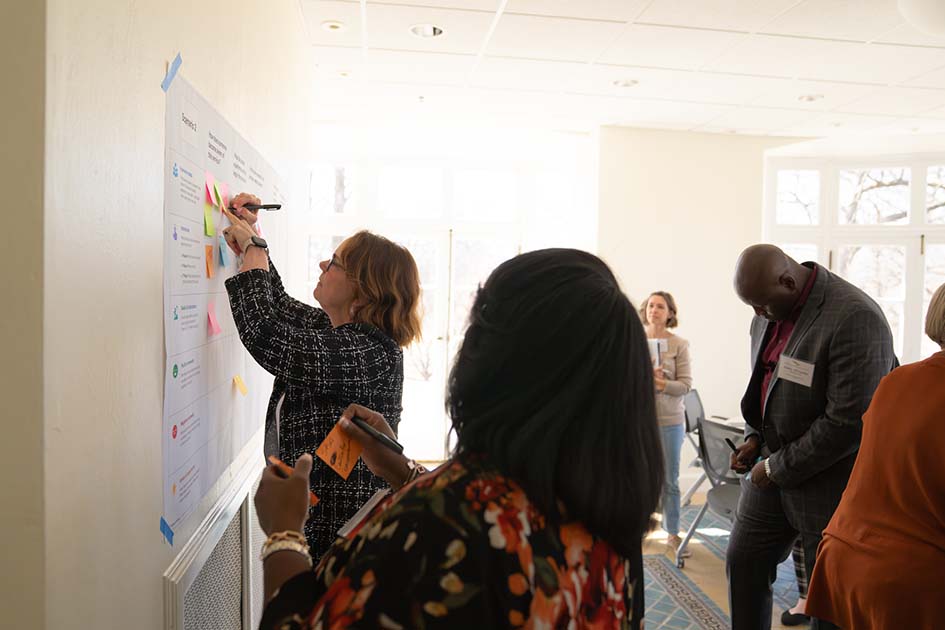The Credit Journey of Lower-Income Households
Let’s say “Gary,” who has part-time work, gets an offer to pick up more shifts during the holidays. He is excited to accept, but his car breaks down and he needs to buy a replacement to get to work. Gary first goes to a bank to get preapproved for a loan, even though he doesn’t have an account there. Gary doesn’t have much experience with banks, so it takes him a long time to complete the application because of the required paperwork and technical language. Due to his part-time income and low credit score, the bank denies Gary’s application. Gary now faces an important decision about how to continue going about getting a car. He is considering one of these next steps:
- Build his credit score over the next six to 12 months and then reapply at the bank.
- Go to a different bank and apply for an auto loan.
- Go to an auto dealer that offers “buy here, pay here” financing.
- Apply for a loan through a financial technology platform.
Gary’s story demonstrates how financial services support financial well-being. If Gary’s credit score had met the bank’s requirements, he would have an affordable, reliable auto loan and a chance to increase his income with the additional shifts he was offered. The loan denial delays his ability to earn more and could even push him to take on a quick but costly and less transparent loan from an auto financer or financial technology platform. Gary’s economic mobility depends in part on the auto loan.
This blog post shares new qualitative analysis about how low- and moderate-income people like the imagined Gary access financial services in Eighth Federal Reserve District communities. (See map.) It describes the journey that people with lower incomes must often take to get an auto loan, credit card or other credit product.

Discussions were held in communities across the Fed’s Eighth District, which is headquartered in St. Louis and covers all of Arkansas, most of Missouri, and parts of Illinois, Indiana, Kentucky, Mississippi and Tennessee.
About the Data
In 2025, the St. Louis Fed’s Community Development staff convened 12 roundtable discussions about financial well-being. Representatives from banks, nonprofits, small business development centers, community development corporations and chambers of commerce participated.
Participant contributions at these roundtables provided on-the-ground insights about how low- and moderate-income people interact with institutions to access financial services.
This analysis builds on a report that includes additional findings from the roundtable conversations. Read the full report.
Why Is Access to Financial Services Important?
The total amount that people and households spend on goods and services accounts for about two-thirds of U.S. economic activity. Limited access to financial services not only leads to negative outcomes for individuals, including greater debt and delinquencies, but could curb spending and savings that contribute to overall financial stability and economic growth. Access to financial services at a bank enables people to more fully participate in the economy.
What Is the Journey to Accessing Credit Like?
The journey around accessing financial services is dynamic and complex. Roundtable participants described the experiences of those who have low and moderate incomes as “complicated,” “not straightforward” and different for each person. The mix of financial products a person uses and their evolving goals are important parts of their journey.
For example, people may use more than one account or credit product at a time. Someone might have a checking account, savings account and car loan at one bank but take out a home loan with better terms from another bank. Moreover, new financial products and services change the options that households and small businesses have to transfer money, make payments or access credit. Some people may use financial technology, or fintech, platforms like Venmo or Cash App to make certain payments but use their credit card or checking account for others.
As a person’s circumstances and goals change, so will their journey. For example, if a small-business owner is approved for a loan, that entrepreneur might want another, larger one in the future to help the business continue to grow. Financial goals may also change with each phase of a person’s life, from student loans for college to savings for retirement.
What Are Key Considerations Shaping the Credit Journey?
Roundtable participants described four key areas that shape how people with low and moderate incomes access financial services: their backgrounds, banks, nonbanks and resource providers. Each is described below.
- Background relates to characteristics and sentiments, like degree of financial literacy and trust in banks, that influence how people think about credit.
- Banks are financial institutions that are insured and regulated, including commercial banks, credit unions and community development financial institutions.
- Nonbanks are financial institutions other than banks, including payday lenders, auto financers and fintech platforms. Affirm, Cash App, Chime, Klarna, PayPal, Sezzle and Zelle were the examples of fintech given by participants.
- Resource providers are organizations—like small business development centers and nonprofits—and programs—like financial counseling—that address gaps in financial literacy and offer support that can be a bridge to greater financial well-being.
Participants also said that public policy, credit bureaus and the labor market may affect a person’s access to credit.

SOURCE: Author’s analysis of discussions at 12 spring 2025 community development roundtables in the Eighth Federal Reserve District.
How Do Lower-Income Households Navigate the Credit Journey?
The journey toward credit for a low- or moderate-income person typically starts with accessing financial services through banks and nonbanks. At which one of these a person starts their journey depends on their background, especially knowledge of and trust in banks. If a person is unfamiliar with banks, had a negative experience with a bank or does not trust banks, they will be less likely to open an account or apply for credit at a bank. Roundtable participants said people with low financial literacy or low trust in banks are more likely to start their journey at a nonbank, like a payday lender, than someone who has more knowledge about and trust in banks.
Those who start their journey at a bank may struggle to open an account or get approved for credit. Participants said that common barriers to using banks for low- and moderate-income people are required documents like tax statements and business plans, technical language and the lengthy application process. While some might have their credit application approved, others may not because they do not complete the process or do not qualify.

St. Louis Fed community development staff members facilitate an exercise at a March 11, 2025, roundtable at the St. Louis Community Foundation. Participants discussed lower-income individuals’ access to credit.
For some low- and moderate-income households, banks’ disadvantages might outweigh their advantages, such as lower interest rates and consumer protections. These people may look for financial services outside of banks.
The speed, ease and availability of nonbank products can draw people to using them. People can get access to an account or a credit offer in minutes through certain fintech platforms. Similarly, payday lenders might have night and weekend hours and convenient locations. Nonbanks often have higher borrowing costs, like double- and triple-digit interest rates, that can be unaffordable over time and trap people in debt. People may also have difficulty building their credit scores with nonbanks. Still, nonbanks might be the best or only option available to some low- and moderate-income people who can’t access accounts or credit at a bank or who face a financial emergency.
People who have a low credit score or debt might turn to a resource provider for help. Participants said that people tend to use resource providers only after trying to access financial services at banks and nonbanks. Resource providers often offer programs for individuals and small-business owners to learn about topics like building a credit score, reading a credit report and understanding different credit products. Resource providers may also help build relationships between people and banks.
What Can Gary’s Story Tell Us about Credit Access?
Like the fictional Gary, many low- and moderate-income people in the U.S. face challenges in getting a loan or credit card because they have limited access to credit. In the first quarter of 2025, an estimated 23.9% of U.S. adults with a credit record had a low credit score (below 660), as the report on the roundtable discussions notes. The percentage of adults living in low- and moderate-income areas who had a credit score below 660 was even higher. In Eighth District states, an estimated 53.2% of adults living in low-income areas and 40.8% of adults living in moderate-income areas had a credit score below 660 in the first quarter of 2025. (See infographic.)
Credit Score Distribution across Income Levels in Eighth District States

SOURCE: Infographic (PDF) for the report “Access to Credit and Financial Services: A Bridge to Financial Well-being.”
NOTES: Data are from the first quarter of 2025. Income levels are census tract income levels. Percentages may not add up to 100 exactly due to rounding.
People with a low credit score are more likely to encounter credit denials or less-favorable terms, like high interest rates. This can make the journey to accessing credit harder and longer, meaning some may struggle to invest in their futures, weather financial emergencies and manage their everyday finances. Gary’s story shows that access to credit can increase economic mobility and strengthen financial resilience.
This blog explains everyday economics and the Fed, while also spotlighting St. Louis Fed people and programs. Views expressed are not necessarily those of the St. Louis Fed or Federal Reserve System.
Email Us


